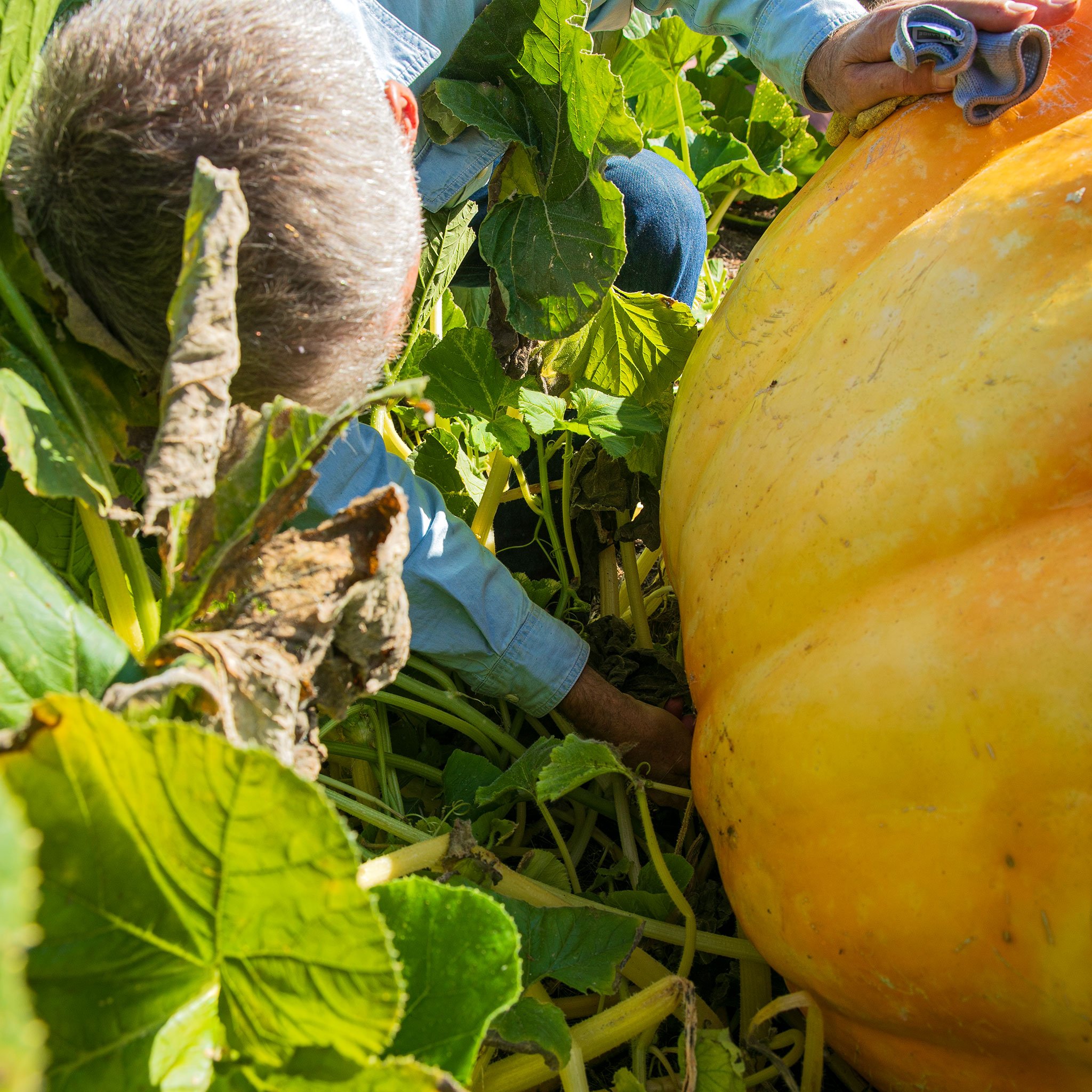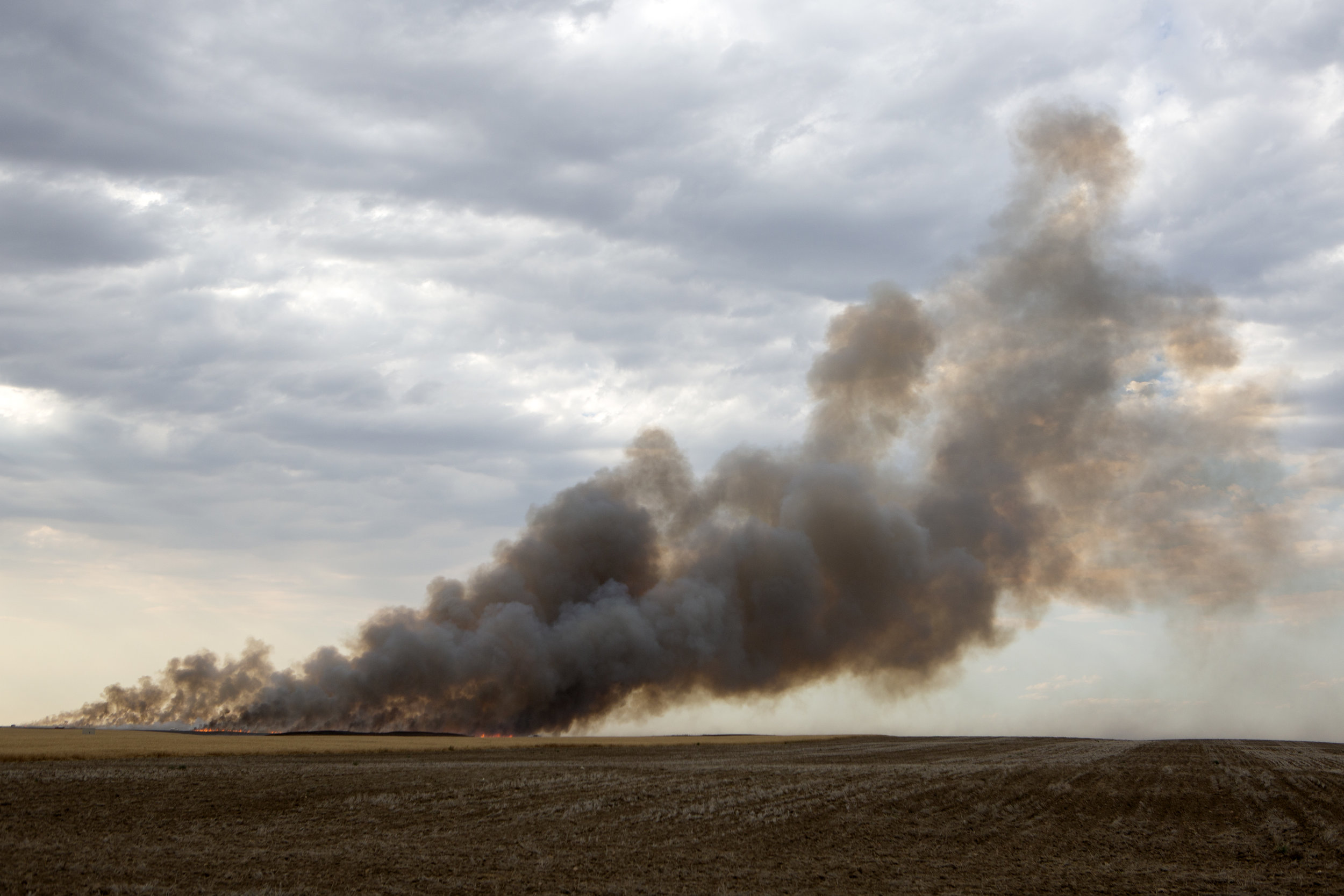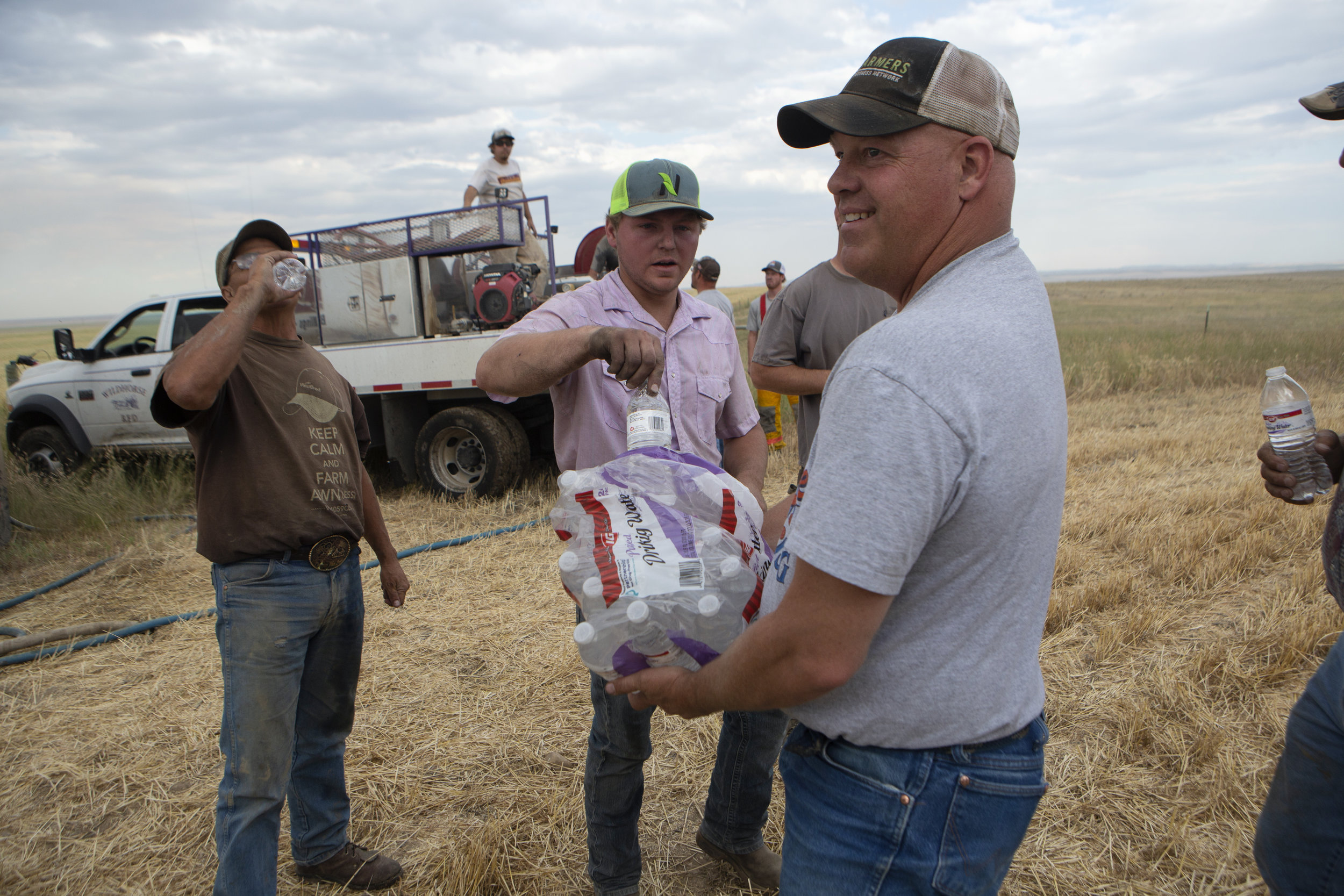To grow a great pumpkin:
Seeds, water, brute force
What is needed to pick a pumpkin — a pair of gloves and some garden clippers?
In Ross Haddow’s case, it takes a small village, too.
For a decade, Haddow, 72, has grown giant pumpkins in the garden of his Edmonds home, and through those years he has called upon neighbors and loved ones to help move the behemoths as he prepares them for weigh-off competitions around Puget Sound.
“It’s a fun hobby,” Haddow said. “It’s fun to grow a fruit that’s bigger than you are.”
Moving a cow-sized fruit is no easy task, though, and it takes more than just brute force to ensure safe passage for the pumpkins. Any significant damage to the flesh can lead to disqualification at local competitions, squandering months of attentive gardening.
So when harvest time comes each fall, Haddow rounds up as many willing volunteers as he can to help safely shepherd his gargantuan gourds from the family garden atop a three-story hill to his pickup truck down below. Haddow and his wife Carla joke that they worry a pumpkin will someday break loose during the move and hurtle down the hill into their neighbor’s pool.
But not this year.
On Saturday, the retired dentist clipped the vine of his beloved pumpkin with friends and family looking on proudly. He confidently called it his biggest to date.
“If the Egyptians could do it, so can we!” Haddow asserted as he and 10-or-so volunteers banded together to heave-ho the beast through the yard. A drag mark in the grass traced the pumpkin’s downhill journey.
After 15 minutes of pushing and pulling — and some crafty positioning involving primitive levers and wedges — the pumpkin arrived safely in the bed of Haddow’s truck, a few inches to spare on each side.
“With a lot of people so that it’s safe, we make quick work of it,” Haddow said.
At the Pacific Northwest Giant Pumpkin Growers weigh-off in Kent the following day, Haddow’s entry landed square in the middle of the pack. Some entries were likely twice the size of his own, he said.
“As soon as I pulled up to the competition, I could tell it was a very good year for growing pumpkins,” he said.
Despite finishing outside the top 10 in the Kent weigh-off, Haddow’s suspicion was confirmed — this year’s is the largest pumpkin he’s ever grown.
As for the exact weight of the humungous squash? Haddow keeps that close to the vest.
Anyone wishing to hazard a guess can visit Shawn O’Donnell’s Irish Pub south of Everett, where the pumpkin will be on display until Halloween. He will also have a second pumpkin on display at A Bit of Taste, an olive oil curator in downtown Snohomish, beginning next week.
For those interested in growing their own giant pumpkin, Haddow says it’s all about finding the right genetics. And while some growers pay heavily for the seeds of prizewinners, Haddow prefers working with leftover seeds from friends at the local growing club.
“Join the Pacific Northwest Giant Pumpkin Growers club. It’s a really exclusive group; (thirty) bucks and you’re a member,” he said with a laugh.
In the end, Haddow said he will harvest the seeds from his pumpkins and hack them to bits with a machete in one last act of Halloween spirit. The orange flesh and guts will be spread in his garden to decompose where, come springtime, they will feed next year’s attempt at growing a true monster.
This story and the accompanying photographs received first place for General News - Large Newsroom in the 2023 NW Excellence in Journalism Awards conducted by SPJ.
Get Outside
Theodore Roosevelt a refreshing national park experience
Yellowstone and Glacier national parks call from the west, but to the east lies another park with much to offer.
Theodore Roosevelt National Park, just inside the North Dakota border about four hours from Billings, is a beautiful representation of everything the northern Great Plains has to offer.
The park was my respite on the first night of a cross-country road trip, though it is certainly worthy of a multi-day stay for hikers and sightseers looking to experience the land that helped inspire Theodore Roosevelt’s conservation efforts.
The park is divided into three sections of badlands — the North Unit, South Unit and Elkhorn Ranch Unit, the last of which is home to a ranch that Roosevelt built in the 1880s.
The South Unit features Cottonwood Campground, which is a fully developed area with accommodations for all styles of camping. The sites are all first-come, first-served and in very high demand. After my drive from Billings, I arrived at 6 p.m. and claimed the last walk-to tent site, which was situated at the end of the campground overlooking the low, muddy Little Missouri River
The campground was buzzing with excitement as people from around the country chatted with each other and expressed relief to be back out exploring after a year of quarantine and isolation.
Cory Tschinkel, a New Yorker on a national parks tour who was staying at Cottonwood, said they and their traveling companion Dylan had hit four connected trails in Roosevelt in their one-day visit, totaling 11 miles of badlands scenery. Tschinkel and some of our other camping neighbors chatted about encounters with wild horses and herds of bison along the trails.
While many of the more than two-dozen trails in the park are intense five-plus hour hikes, even more are quite easy on the legs.
In my brief few hours exploring the South Unit, I visited the Jones Creek Trail — which is a long but flat hike that parallels a small creek through the dry landscape — and the Skyline Vista — a short, paved path leading to an overlook that gave a beautiful sunset view of the badlands and the small town of Medora. My fellow campers also recommended the Buck Hill Trail and the Painted Canyon Nature Trail, which are in the South Unit and relatively easy hikes.
Theodore Roosevelt National Park is a hiker’s delight with countless scenic badland views and multiple historic sites worth visiting. Plus, park visitation numbers reach only around 600,000 people a year, which makes for far less foot and vehicle traffic than a place like Yellowstone — though bison jams are still very much a part of the park experience.
Wildfire
claims 500 acres
Communities unite as fire season gets off to hot start
Several agencies responded to a large brush fire south of Fresno Road between Havre and Kremlin on Wednesday. After almost three hours of battling fast-moving flames, a patchwork group of local departments and neighboring farmers were able to extinguish the fire after it claimed about 500 acres of wheat and pasture.
Bear Paw Volunteer Fire Department Chief Josh Bebee said the response went well despite the loss of crops.
"We managed to corral it," he said. "It was starting to get into some pretty rough country. ... I'm happy with the way it turned out."
Bear Paw received the call to the fire just after 5 p.m. and responded to the scene alongside the Kremlin Fire Department.
A number of other agencies also responded to the scene including Havre, Box Elder, Gildford and Wildhorse, he said. Several landowners and neighbors also assisted with fighting the fire, bringing trucks and 18-wheelers with water tanks to help contain the blaze.
Bebee said that the blaze was extinguished by 8 p.m. but a few departments were standing by and surveying the area for potential hot spots that could reignite.
A brush fire outside Big Sandy was reignited last week after burning inside a tree stump for over half a day after the flames were thought to be out.
Bebee said Wednesday’s fire was likely caused by a combine harvesting wheat.
Reuben Scheuerman, a local farmer who helped extinguish the flames, said fires like this one are just a part of living in Montana. He added that it’s important for farmers and ranchers to team up and protect their land from wildfires in such rural country.
Bebee said locals should be cautious of fire hazards during this time of year as high temperatures and low humidity plague the Hi-Line.
“It’s drying out real quick, and it doesn't take much for [a fire] to get going," he said. "Everybody needs to be vigilant and careful. If they are out in the tall grass, just pay attention to what they are doing and hopefully we'll have a good season."
Derek Hann contributed to this article.
Get Outside
Crazy Mountain cabin provides stunning views, trail access
Coyote howls echoed across the Shields Valley as we unpacked our gear in the failing daylight for a two-night stay at a 100-year-old Forest Service cabin.
Situated at an elevation of 6,400 feet on the northwest side of the Crazy Mountains near Wilsall, Porcupine Cabin was the post-Christmas weekend destination for myself and four friends.
I’m not so sure it was the snow that brought me to a stop on the 16-mile drive in. More likely it was the fact that my Honda Accord has bald tires. So I ditched my car about a mile into the 1,000-foot climb and hitched a ride the rest of the way with my four-wheel drive-equipped friends.
After a straight shot up the snow-dusted dirt road, we weaved through a grove of trees and the cabin came into sight. The steep, snowy hillside of Bald Ridge rose behind the structure, while below was an expansive view looking across the Shields Valley.
The cabin was built in 1914 after a previous structure burned down, according to the recreation.gov website. In 1934 the Civilian Conservation Corps remodeled the structure for use by Forest Service rangers. In snowier winters, visitors may have to ski, snowmobile or snowshoe in the last two miles, which is not plowed. A screened front porch faces the valley.
Newbie
This being only my second stay in a Forest Service rental cabin, my comparative scope is quite narrow, but my immediate takeaways were the cabin is spacious and decked out beyond expectations considering it’s only $45 a night.
A clean vault toilet was a luxury, given the location.
Eight beds, two dining tables with enough seating for a small army, a pantry area stocked with cooking and dining gear, and all the accoutrements a cabin-goer could desire were available.
The wood-burning stove is sweat-through-your-shirt, strip-it-off-and-crack the-windows hot. That is significantly better than being huddled around an ineffective stove all night, which is the situation we found ourselves earlier in the year at West Bridger Creek Cabin.
Porcupine Cabin is a non-electric spot, so we were sure to bring enough lighting and power banks to last us through two nights of socializing and playing cards. A propane lantern was provided, though cabin guidelines ask guests to refrain from using it indoors. Visitors have to pack in their own drinking water to this cabin, as well.
Visitor
The first morning of our stay we received a visitor in the form of a snowy white weasel. While not certain, I think it was a least weasel — North America’s smallest carnivorous mammal. Whatever it was, that tiny creature, with its beady eyes and pink button nose, truly defined the verb “weasel” when it manifested from a tiny crack in the door frame.
Our presence caught it off guard, as it gave us a puppy dog head-tilted-sideways glance before scurrying behind a desk, only to return, take one last look and then scoot back through the crack from whence it came. If only I had my camera at the ready.
Outside
Following coffee and breakfast, I ventured out to see what the trailhead directly adjacent to the cabin had to offer. Heading south from the cabin is the new Porcupine Ibex Trail No. 267, but I wanted to see what the old Shields Lowline Trail No. 258 had to offer.
The first half-mile travels east toward the mountains through pine trees and maxes out at a tough 31% grade. At about the one-mile mark hikers reach Bald Ridge before the trail levels out and drops into the South Fork of the Shields River for eight miles. I stopped my hike at the ridge because the snow began to deepen, but one of the couples I was with went further up and said the top of the ridge provides a beautiful view of surrounding peaks like Sugarloaf Mountain and Black Peak.
We had plans to cross country ski that day, which would have been my first time, but Mother Nature had other ideas. As of late December the dry winter had hardly spit any snow onto the Crazy foothills, so I resorted to plopping around the vicinity of the cabin for a bit to get a feel for what cross country skiing is all about. Verdict: I don’t yet get it.
Views
Watching the day turn to night over the Shields Valley is a view to behold, with the Bridger Mountains some 25 miles to the west changing colors and the glowing lights of Wilsall slowly coming into view as darkness takes hold. It seems the cabin is as equally equipped for peaceful meditation as it is for debauchery with old friends.
On the morning of our departure, I woke up early to have coffee and watch the sun rise from the fire pit out front of the cabin. It was serene. The view of the Bridgers was inspiring, and watching a wall of sunlight race toward us through the Shields Valley was incredible. We had the cabin cleaned up and were ready to go early. As we loaded our last belongings into vehicles, a group of snowshoers arrived, ready to take up temporary residence.























